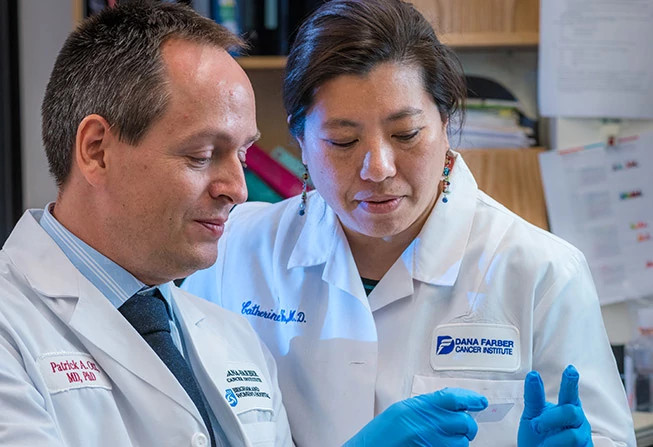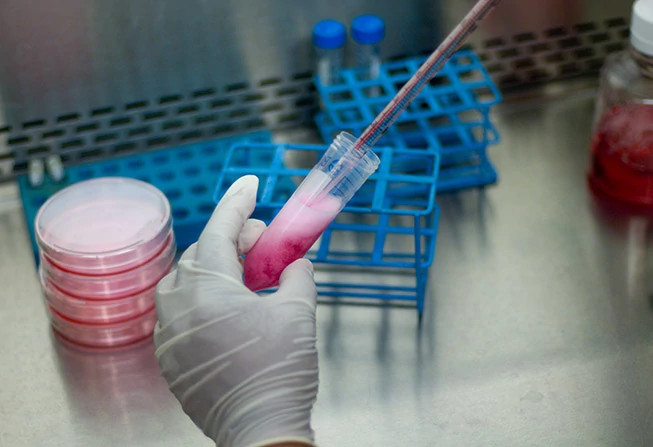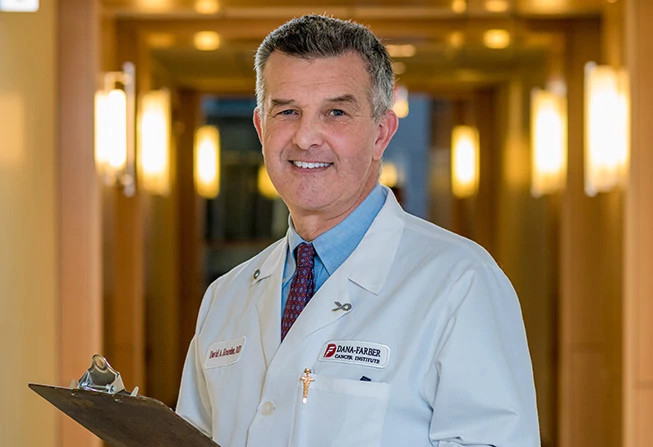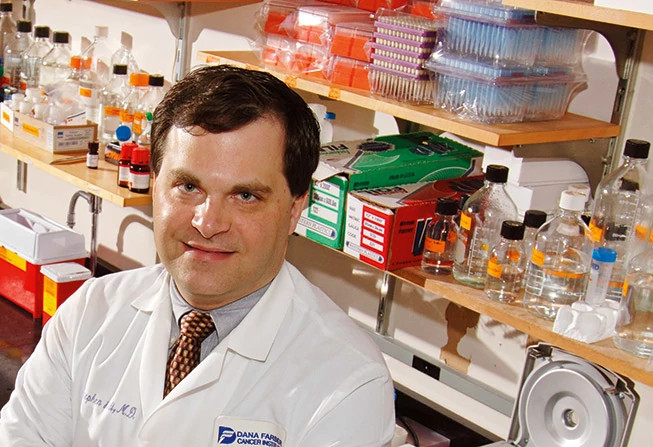Taking Aim With Neoantigens
Immune System Targets Called Neoantigens on Cancer Cells Are Fueling a New Breed of Anti-Tumor Vaccines
From Paths of Progress 2017
By Richard Saltus

It's a compelling idea that has attracted scientists for decades: rather than poison tumors with chemicals and radiation, use a biologic agent — a vaccine — to rally the body's formidable immune defenders to kill cancer cells and shrink tumors.
Yet, even as other forms of immunotherapy are showing promise against some cancers, efforts to make an effective and safe cancer treatment vaccine have struggled.
Treatment vaccines differ from preventative vaccines, such as the human papilloma virus (HPV) vaccine, which prevents cancers caused by certain strains of HPV. A treatment or therapeutic cancer vaccine, by contrast, is designed to stimulate a patient's immune system to attack cancer cells. Only one such vaccine — Provenge, for advanced prostate cancer — is approved for wide use. Much of the time, despite researchers' best schemes, vaccines have failed to land much of a blow against cancer.a
But rather rapidly, a series of molecular discoveries, together with increasingly powerful DNA sequencing methods and predictive computer algorithms have brought a promising new vaccine concept based on "neoantigens" to the table — and, just recently, to the clinic.
The Neoantigen Approach
Neoantigen vaccines are highly personalized therapies. An antigen is any substance the body encounters that provokes an immune response. "Neo" antigens are molecules newly minted by mutations that occur randomly as cancer cells divide and grow. Neoantigens are unique to each patient and his or her cancer, and — critically important — can be recognized by the immune system as foreign. The neoantigens from a patient's tumor are used to make a customized vaccine that stimulates the immune system to react against cancer cells that carry the selected neoantigens.
"It's a new thrust — neoantigens are reinvigorating the vaccine field," says Catherine Wu, MD, a Dana-Farber physician-scientist who has discovered unique mutated neoantigens in leukemia and is a leader in neoantigen vaccine development.
Scientists have long tried to create cancer vaccines that contain a distinctive antigen — some molecule or part of the cancer cell which would spur an immune response against the tumor, while leaving normal organs and tissues in the body unscathed. The problem is, while the immune system can recognize antigens on cancer cells, these antigens tend to be similar to those on normal cells. As a result, the immune system fails to respond with enough power to subdue tumor growth. Cancer cells are also adept at hiding their identifying antigens.

"Finding a good antigen for a cancer vaccine has been difficult because most are 'self-antigens' — they induce tolerance by the immune system," explains Patrick Ott, MD, PhD, clinical director of the Center for Immune Oncology at Dana-Farber. Tolerance refers to the lack of an immune reaction against an antigen perceived as harmless.
Neoantigens are unique not only to the cancer but also to the individual patient; they are antigens that the immune system has never encountered. As a result, the body's defenses should have zero tolerance for a cell bearing a neoantigen.
Wu and Ott, working with collaborators at the Broad Institute of MIT and Harvard, have developed a personalized neoantigen-based vaccine called NeoVax. NeoVax is in early trials at Dana-Farber in patients with advanced melanoma, glioblastoma brain tumors, and kidney cancer. The scientists say the vaccine, which is injected under the skin, appears to trigger strong immune activity in some patients, with no safety problems.
"What's exciting about neoantigen vaccines is that the T-cell responses to these peptides tend to be highly tumor specific," says Kai Wucherpfennig, MD, PhD, chair of Dana-Farber's department of Cancer Immunology and Virology. "I think this is going to be important."
Neoantigen vaccines are in very early human testing and haven't yet been shown to benefit patients. They have, however, been shown to control cancer in animals. There is also indirect evidence for the power of neoantigens in humans. Some studies have found that patients treated with checkpoint inhibitors have better outcomes if their tumors contain greater numbers of neoantigens. This suggests that the patients' immune systems are reacting more strongly to the tumor because of neoantigens on the cancer cells' surface, and scientists see this as an indication of how a neoantigen vaccine would cause a more potent immune response.
Even at this early stage, Wu and her colleagues are confident they are onto something transformative.

In a 2013 paper published in Cancer Immunology Research, she and her co-authors wrote: "We are entering a new era of cancer immunotherapy in which a sophisticated vaccine loaded with patient-specific neoantigens is poised to generate a powerful yet precisely targeted antitumor immune response."
Any success that neoantigen vaccines may have, they will owe in part to rapidly developing DNA sequencing technology and computational bioinformatics.
It's been known for many years that new mutations occur as cancer cells evolve — mutations that didn't necessarily cause the tumor or drive its behavior, but occur only in the cancer cells and not in healthy cells. Only in the past few years, with powerful whole-exome sequencing technology, has it become feasible to rapidly search through the protein-coding parts of a patient's normal genome and the tumor's genome in order to identify all the mutations that have occurred.
To make a neoantigen vaccine, scientists first sequence the patient's tumor exome DNA and compare it to the DNA of the patient's normal tissue to reveal neoantigens in the tumor. Next, they use computer algorithms to predict which neoantigens are most likely to bind to antigen-presenting cells in the patient's immune system — necessary to provoke a strong immune response. Then the DNA code for those neoantigens is used to make peptides — pieces of protein — that go into the vaccine, along with an immune-stimulating substance called an adjuvant.
Ideally, Wu says, a vaccine would contain all the neoantigens discovered by sequencing the tumor DNA, but for practical reasons the NeoVax vaccine uses a smaller number — around 16 to 20 neoantigens, for example, in the melanoma vaccine.
Testing the Strategy
In the ongoing clinical trials, the neoantigen approach is showing encouraging activity and safety profiles.
In one Dana-Farber study, the NeoVax vaccine is being given to six patients with melanoma who have had their tumors removed surgically. The study is examining the safety of the vaccine and whether the vaccine is triggering an immune response among T cells called CD4 and CD8. Says Wu: "Based on our computer predictions, we generated vaccines directed against antigens on the tumors, and all four of the patients with stage III disease have remained in remission."
The two patients with stage IV disease who had recurrences were treated with pembrolizumab, an immune checkpoint-blocking drug, and went into complete remission, says Wu. In addition, patients treated with the combination of vaccine and pembrolizumab had persistent and broadened neoantigen-specific responses. "This is very exciting, because at the very outset, our concept was not to use the vaccine alone — we wanted to use available tools and put them together," she notes. The vision was to use the vaccines to "steer" the immune response to focus on the neoantigens, in combination with the checkpoint inhibitor drugs, such as those that target PD-1 and PD-L1, to release the "brakes" on the immune reaction to attack the cancer.
Scientists say checkpoint blockade drugs could make vaccines more effective, and vice versa.
In a clinical trial led by David Reardon, MD, clinical director of Dana-Farber's Center for Neuro-Oncology, nine patients with glioblastoma brain tumors received the NeoVax vaccine following surgery. Reardon says that "while it is too early to assess impact on survival outcome, we have been able to demonstrate robust T-cell immune responses" to neoantigens in some patients, with no safety issues.
A second trial combining NeoVax with a checkpoint-blocking drug for newly diagnosed glioblastoma patients has been approved and should open this year.
Vaccine Research Gets a Shot in the Arm

The neoantigen concept has spurred a wave of investment and startup companies. One enthusiast is Sean Parker, the Silicon Valley entrepreneur and founder of the Parker Institute for Cancer Immunotherapy. In December, the Institute announced a collaboration for neoantigen vaccine research that includes Dana-Farber, the Broad Institute of MIT and Harvard, Cambridge-based Neon Therapeutics and a number of academic research centers and companies. The collaboration will enable different research groups to compare methods for predicting which neoantigens (based on their DNA sequence) will be most potent in a vaccine.
NeoVax isn't the only advance in vaccine research being developed by Dana-Farber investigators.
In a highly encouraging recent study, Dana-Farber's Donald Kufe, MD, and collaborators at Beth Israel Deaconess Medical Center (BIDMC) showed that a personalized cancer treatment vaccine was highly effective in preventing relapses in older patients with acute myeloid leukemia (AML) who were in remission following chemotherapy.
Kufe, who discovered MUC1, an important cancer-related protein, spent years making a cancer treatment vaccine against it, as well as neoantigens. His team fused cancer cells from patients with dendritic cells (key immune cells that process antigens and alert the immune system to attack them) from the same patient to form a hybrid hunter-killer product. They then used that product as a vaccine to stimulate the immune system to attack the patient's cancer cells.
"The development of this personalized vaccine was based on the premise that effective treatment of established cancers would require the induction of immunity against multiple antigens, including neoantigens, specifically expressed by the patient's own cancer cells," says Kufe. Support from the Barbara and James Sadowsky Family made the development of this vaccine possible.
In a trial based at Dana-Farber and BIDMC, the personalized vaccine markedly improved outcomes in AML patients who were in remission but at risk for relapsing. The researchers said it generated a broad and durable immune response against MUC1 and other cancer-related antigens without significant side effects.
As a result of these findings, a multicenter national trial for patients with AML has been initiated with support from the National Cancer Institute. In addition, this personalized vaccine is being evaluated in an ongoing multicenter national trial for patients with multiple myeloma (MM), based on evidence of immune responses against MUC1 and other MM-related antigens, and clinical activity.
Testing the First Implantable Human Vaccine

A clinical trial of patients with advanced melanoma at Dana-Farber/Brigham and Women's Cancer Center is the first to evaluate an implantable vaccine device placed within their bodies to promote an immune response against tumors.
The thin, fingernail-sized round wafers are made of synthetic polymer materials and are implanted under the skin. Each vaccine wafer contains fragments of the patient's cancer cells, which act as an antigen to incite an immune response, along with GM-CSF and CpG, immunity-stimulating compounds.
The vaccine chips are implanted near lymph nodes, part of the immune system, and are designed to attract dendritic cells into the chips. Dendritic cells capture foreign antigens and present them to T cells, which then seek and attack cells bearing those antigens. The goal is to generate a force of activated dendritic cells that will "prime" T cells to destroy cancer throughout the body.
The patients receiving the chips are being treated as part of a clinical trial headed by F. Stephen Hodi, MD, director of the Center for Immuno-Oncology and the Melanoma Center at Dana-Farber. Each patient has four vaccine chips prepared and implanted one at a time. Over time they are absorbed into the body.
Hodi says no safety concerns have arisen. "The patients get a local reaction and we are measuring immune changes in the blood and tumor sites that suggest immune activation" by the dendritic cells, he says.
The vaccine chip concept was originated by bioengineer David Mooney, PhD, at the Wyss Institute for Biologically Inspired Engineering, and the vaccine wafers are manufactured at Dana-Farber's Connell and O'Reilly Families Cell Manipulation Core Facility.
Request a Publication
Receive by mail the current issue of a Dana-Farber publication by completing this request form.
Media Contacts
If you are a journalist and have a question about any of our stories or need more information, email media@dfci.harvard.edu or call 617-632-4090 and ask to speak to a member of the media team.
The Media Team cannot respond to patient inquiries. For more information on contacting Dana-Farber, please see Contact Us.